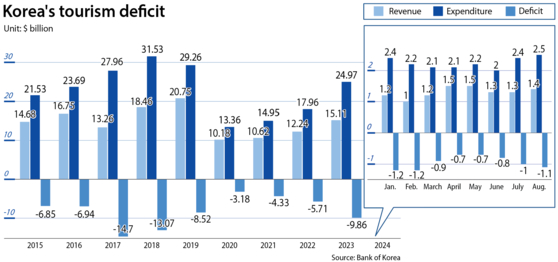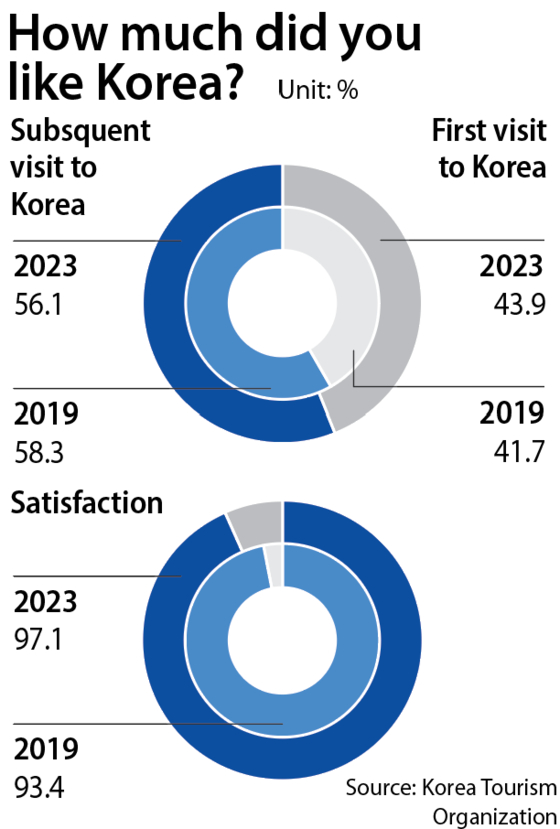Korea wants 30 million annual tourists by 2027. But what is the country doing about it?
![Tourists take selfies in front of the King Sejong statue at the Gwanghwamun Square, central Seoul, on Oct. 9. [YONHAP]](https://koreajoongangdaily.joins.com/data/photo/2024/10/31/e0470f2b-7463-4fb6-b766-5fd2ffc605d4.jpg)
Tourists take selfies in front of the King Sejong statue at the Gwanghwamun Square, central Seoul, on Oct. 9. [YONHAP]
Two years ago, Korea dared to dream. It was the dream of attracting 30 million annual tourists by 2027, a number almost double that of the highest ever achieved by the country in 2019. This came at a time when tourism was at its peak, with the area being the fifth-largest export sector in Korea following semiconductors, cars, petroleum and auto parts.
The dream coincided with an optimistic outlook for the tourism industry as the world slowly awaited the end of a pandemic that had kept the global population frozen without movement. Travel began to resume, regulations were easing and Korea had risen as a provider of popular online content that had kept people entertained during the lockdown — the likes of Netflix’s “Squid Game” (2021) and online concerts by K-pop stars.
So, when the government enthusiastically announced that it would begin its tourism push with a humble target of 20 million inbound tourists in 2024, hopes were high that the goals could actually be met, especially since the Yoon Suk Yeol administration had pitched tourism as a focus area for the virus-stricken domestic economy.
As this year heads toward a close, however, tourism statistics so far give reasons for both applause and constructive criticism.
This year, Korea has seen 10.69 million foreigners visit the country from January to August. That’s up 62.9 percent on year but still 6.8 percent short of the 11.47 million that 2019 saw during the same eight-month period prior to the pandemic. If Korea wants to meet its goal of 20 million by December, then the numbers really need to increase in a much more dramatic way.
In a country suffering from a chronic tourism deficit, the government is working to make the country appealing to both foreigners and citizens by using existing cultural resources, mostly festivals and leisure events, as well as developing new facilities to accommodate travelers with specific interests, such as medicine or pop culture.
![Tourists at the streets of Myeong-dong, central Seoul, on Oct. 27 [NEWS1]](https://koreajoongangdaily.joins.com/data/photo/2024/10/31/6fd6df64-9207-4640-a1f4-a474a7e634cc.jpg)
Tourists at the streets of Myeong-dong, central Seoul, on Oct. 27 [NEWS1]
The year still has two months to go, and the government’s strategy has three more years to prove itself, but any change in the government’s strategies, if they are indeed needed, may have to take place during the approaching colder season to be effective next year.
K-tourism to the rescue
Three major missions were set for this year to meet the 20 million goal: utilize K-culture and K-content to attract foreign travelers; upgrade non-capital cities to facilitate regional travels for both foreigners and Korean citizens; and improve existing tour programs that have been proven successful, especially medical and package deals.
Major missions included establishing “mega-events” based on the popularity of K-culture, such as the Korea Grand Sale, Korea Summer Beauty Sale and K-Link Festival, and using the popularity of K-pop and K-drama for marketing inbound tourism to overseas countries.
Discount coupons were given out to encourage domestic travel and regulations were eased for local businesses, while visa policies were streamlined for foreigners.
![Tourists at the streets of Myeong-dong, central Seoul, on Oct. 27 [NEWS1]](https://koreajoongangdaily.joins.com/data/photo/2024/10/31/9ed476de-3051-4f4e-b5f2-7e6c003252da.jpg)
Tourists at the streets of Myeong-dong, central Seoul, on Oct. 27 [NEWS1]
Travel agencies were encouraged to come up with tour packages to meet changing trends, with large-sized group tours making way for more individualized programs that cater to smaller groups looking for newer, fresher events. Agencies that had been caught trying to rip off tourists by offering seemingly cheap deals — but forcing travelers to buy items to earn commission — were penalized and even shut down.
“Tourism is a major pillar of trade profit and an industry that encompasses all aspects of the country’s sectors, including culture, economy, diplomacy, environment and security,” Prime Minister Han Duck-soo said when first announcing the government’s plans to boost tourism on Dec. 8, 2022.
“It is also a crucial means of overcoming the difficulties that we are facing amid inflation, high interest and high currency exchange rates that hinder our country. We vow to achieve 30 million tourists and $30 billion in tourism revenue by 2027.”
![Tourists at the Gwanghwamun Square, central Seoul, on Oct. 9 [YONHAP]](https://koreajoongangdaily.joins.com/data/photo/2024/10/31/a63d1b72-0b6c-41f2-91cc-aff359098004.jpg)
Tourists at the Gwanghwamun Square, central Seoul, on Oct. 9 [YONHAP]
The government has held seven meetings led by Prime Minister Han to meet its ambitious tourism targets, which were attended by the ministers of 13 government ministries, including the Culture Ministry along with the Ministry of Economy and Finance, the Ministry of Land, Infrastructure and Transport and the Ministry of Justice.
The Ministry of Culture, Sports and Tourism allocated 1.31 trillion won ($957 million) to spend on the tourism sector in 2024, which was 6.6 percent more than the previous year and 3.8 percent higher than the average increase across the ministry’s sectors — and almost a fifth of the ministry’s whole budget of 6.95 trillion won for 2024.
The tourism budget for next year is planned at 1.35 trillion won, up 2.4 percent compared to 2024, of which 586.5 billion won will go to loans for tourism businesses, 33 billion won for funding tourism businesses, 78.8 billion won for developing a “K-tourism leisure belt” in the southern regions of the country, 10 billion won to go toward marketing expenses targeted at foreigners and more.

Tourism graphic
Ambitious or fictitious?
The plan has come at the right time, but perhaps not in the best manner.
Hopes were indeed high for the tourism sector at the beginning of 2023. People were ready to spend money on travel as the pandemic subsided, and K-content had opened up the world’s heart to K-culture. However, tourism has always been one of Korea’s weaknesses compared to other leading countries in Asia, leaving huge room for improvement.
In fact, the tourism industry only took up 2.8 percent of Korea’s GDP in 2019 even when the sector was at its peak, significantly lower than the average, 10.4 percent, for the top 51 member nations of the World Travel & Tourism Council during the same period.
The number of inbound foreigners to Korea in 2019 was 17.5 million, which saw a huge dip during the pandemic and recovered to 11.03 million in 2023. The 2019 record was touted by members of the government to mean that the nation had achieved 17 million inbound "tourists" when genuine tourist numbers — those who had come to travel — only reached 14.4 million that year. The number of tourists dropped further in 2023 to 8.9 million.

Tourism graphic
The number of returning visitors has decreased compared to 2019, when 58.3 percent of inbound tourists had visited Korea in the past. This decreased to 56.1 percent in 2023. The percentage of people who were satisfied with touring around Korea increased from 93.4 percent in 2019 to 97.1 percent in 2023, but the percentage of those who were dissatisfied also rose from 0.3 percent in 2019 to 0.4 percent in 2023.
Making matters worse is that Koreans don’t like to travel around Korea, hence the government’s endeavors to boost domestic tours.
Korea has been logging a deficit in its travel balance for 61 consecutive quarters, meaning that Koreans have spent more money on traveling abroad than traveling in the country or foreigners coming to Korea. The tourism deficit came in at $6.48 billion during the first half of 2024, the largest in six years, and has been seeing a growing trend of monthly deficits since June this year.
Much of the worsening deficit can be blamed on “people’s misplaced superstition that overseas travel costs less than domestic travel,” according to a report by market analysis firm Consumer Insight released on Tuesday.
“Overseas travel typically costs seven times more than domestic travel, but people still believe that it costs less,” read the report. “Around 88 percent of people have heard the phrase, ‘The amount of money you need to go to Jeju Island will get you to Japan,’ and 88 percent of people believe that to be actually true. The failure to eradicate such an ungrounded belief will perpetuate Korea’s tourism deficit.”
![Tourists at the Gyeongbok Palace, central Seoul, on Oct. 12 [NEWS1]](https://koreajoongangdaily.joins.com/data/photo/2024/10/31/bdf2df62-0873-425d-a7cd-65969fb8947c.jpg)
Tourists at the Gyeongbok Palace, central Seoul, on Oct. 12 [NEWS1]
Looking ahead
The goal of 20 million for 2024 does not seem feasible when looking at the numbers so far, but the Culture Ministry remains cautiously optimistic.
Inbound foreigners surpassed 12 million as of October, which is 93.4 percent of the amount compared to the same period in 2019. This was “a feat achieved amid Japan’s weakened yen rate, China’s deteriorating economy and the inconveniences of the K-ETA policy” that made Korea less attractive to visitors, according to Jang Mi-ran, Second Vice Minister of Culture, Sports and Tourism.
Japan has been enjoying a surge of inbound tourists due to a weakened yen, which has been attracting overseas travelers seeking to get the best out of the exchange rate. China’s economic crisis has also rippled through to the Korean tourism market, which had heavily relied on large-scale group tours coming from the neighboring country.
Problems with the K-ETA policy, which is an electronic travel authorization system that was put forward in 2021, led 9,947 group tourists from Thailand to cancel their trip to Korea last year. Major Thai celebrities had their K-ETAs canceled for various reasons and then failed to get refunds on their expenses, according to data from the Korea Tourism Organization compiled by Rep. Kang Yu-jung of the Democratic Party.
![A tourist takes part in a "personal color" event on Oct. 22 at the Gwanghawmun Square in central Seoul. [YONHAP]](https://koreajoongangdaily.joins.com/data/photo/2024/10/31/a0dfd0d2-7f9e-466a-b194-be31d2884c9e.jpg)
A tourist takes part in a "personal color" event on Oct. 22 at the Gwanghawmun Square in central Seoul. [YONHAP]
![Tourists take pictures wearing Korean traditional dress hanbok at the Changgyeong Palace on Oct. 16, central Seoul. [NEWS1]](https://koreajoongangdaily.joins.com/data/photo/2024/10/31/88fe5695-f04f-4346-87ab-cb31f5255a29.jpg)
Tourists take pictures wearing Korean traditional dress hanbok at the Changgyeong Palace on Oct. 16, central Seoul. [NEWS1]
“The goal of 20 million is a symbolic goal in order to become a tourism champion,” Cha told the Korea JoongAng Daily. “The government is working not only on the quantitative expansion of the tourism industry but also on enhancing the quality of tourism that can be proven through the duration of stay, amount of money spent during the trip and the diversification of the nationalities of people visiting Korea.”
Though this year’s numbers may seem humble, the headwinds are expected to subside next year with the yen slowly inching up to give the upper hand to Korea. More younger travelers are coming to Korea seeking individualized programs, which the government aims to cater to.
“We are planning on developing hands-on experience programs in collaboration with related industries, such as K-food and K-fashion, so that foreigners may enjoy the everyday activities of Korean people, including eating chicken at the Han River parks and riding bikes,” Second Vice Minister Jang said.
“We will also work closely with related ministries, such as the Ministry of Justice, so that we can improve entry policies, including visas and the K-ETA, so that foreigners may access Korea easier.”
BY YOON SO-YEON [yoon.soyeon@joongang.co.kr]


No comments
Post a Comment